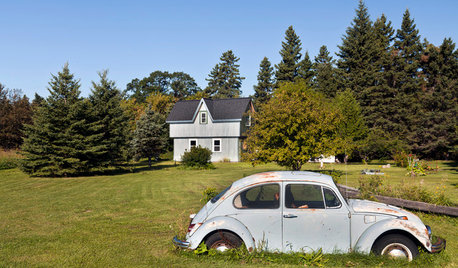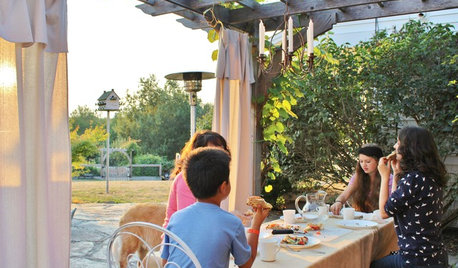In response to Tornadoman's question on another thread about the cucurbit family, here's some growing tips that apply equally to all members of the cucurbit family, which includes summer squashes, winter squashes, pumpkins, cucumbers and melons.
1. SOIL PREPARATION: All cucurbits are rampant growers who enjoy soil enriched with manure and compost. The best soil for them is a sandy or loamy soil with lots of organic material. However, they will grow well on clay soil if it has adequate amounts of organic material like compost, humus, manure, or shredded, decomposed leaves added to it. It is important that the soil be well-drained as these plants don't like waterlogged soil.
Raised beds are optional. Most cucurbits do just fine on beds that aren't raised, as long as they drain well. The advantage of raised beds is that the soil warms up quicker, and cucurbits like warm soil, and also that it is more well-drained than beds that are not raised. Squash family plants do best in soil with a pH of 6.0 to 6.8. They can grow at soil outside of that pH range, but may have problems taking up the nutrients from the soil.
Of all the cucurbits, melons are the most picky about soil.
2. PLANT WHEN THE AIR AND THE SOIL ARE WARM. Cucurbits do not like cool soil temps or cool air temps. Raised beds warm up faster and allow you to plant earlier. Many people cover their future cucurbit beds with a layer of black plastic for 3 or 4 weeks prior to planting in order to warm up the soil. You can plant cucurbit seeds in the soil when soil temps are in the 60s, but I like to wait until they are in the 70s. You can direct seed cucurbits in the ground, or you can plant them from transplants either purchased or raised by yourself. You don't gain much advantage, if any, by planting cucurbits when it is still cool. If the ground and air are too cool, the seeds won't sprout and the transplants won't grow. In fact, planting too early can stunt the plant growth.
3.Some cucurbits are vining plants and require a lot of room. Others are bush plants and take up less space. Read the back of the seed packet to determine the final spacing of plants, or check the tag that came with your transplants.
Be sure to give these plants enough room. If you plant them too closely to a less aggressive plant, they will just cover up the less aggressive plant and prevent it from doing well. Proper spacing also allows for good ventilation which helps minimize foliar diseases.
4. Many people like to raise the cucurbits on top of black plastic laid on the soil. The plastic warms up the soil (good idea in the spring, bad idea in our hottest months) and help prevent soilborne diseases from reaching the leaves. One solution is to start out with black plastic in early spring and then cover it with a mulch like straw. grass clippings, wood chips, etc. as summer arrives, so the soil won't be too hot. Keep in mind that black plastic can interfere with irrigation unless you place soaker hoses or drip irrigation underneath the plastic.
5. Some people use spun polyester row covers to keep bugs and soil-borne pathogens off their plants. If you do this, remember that you have to remove the row covers in order for pollination to occur.
6. Mulching your cucurbits helps reduce competition from weeds, conserves soil moisture and prevents soil-splash of soil-borne pathogens. It is highly recommended.
7. Watering is best accomplished through the use of soaker hoses or drip irrigation. The more water you get on the leaves of your plants, the more foliar diseases you will have.
8. Bees are essential to good pollination. If you use insecticides in your garden, you run the risk of wiping out the bee pollination, so use insecticides carefully if at all and check the labels carefully for tips on the best way to use them. The bee population has been suffering from mite depradation for years and now a new disease has appeared in which whole hives of bees suddenly die off. If you have bees, appreciate them and don't harm them. Your garden needs them.
9. Keep weeds out of your cucurbit beds as they compete for soil and moisture. This is most easily accomplished through mulching and by removing weeds while they are very small.
10.Squash vine borers, both striped and spotted cucumber beetles, squash bugs, and aphids are the main insect pests. Use of insecticies, either organic or non-organic, may be necessary. There are a couple of organic ways to minimize pest problems. For squash vine borers, wrap the above-ground portion of the plant stems at the base of the plant with aluminum foil to prevent entrance by squash vine borers. Also, as the stem runs along the ground, mound soil up over it so that portion forms its own roots. Then, if a squash vine borer invades, the secondary rooting may save the plants.
Squash bugs lay their eggs on the undersides of the leaves. You can save yourself a lot of trouble if you find and remove those bright red eggs before they hatch.
Also, you can lay a board or shingle on the ground near your cucurbit plants. The bugs will congretate under that board for protection at night. In the morning, lift up the board and remove and destroy the bugs.
You can help reduce your squash vine borer problem by coating the plants and the ground they stand on with diatomaceous earth (an organic pest control made from ground-up sea fossils) or ground-up oyster shells. Be sure you DON'T use the diatomaceous earth made for swimming pool maintenance. It is not the right kind and can harm your garden.
For prevention of squash vine borers, you can use BT, which is Bacillus thuringiensus. I, however, no longer use Bt in my garden because it wipes out the butterfly population.
Insects are always more of a problem on plants that are overfertilized and overwatered, so try to avoid both those circumstances.
11. With winter squash or pumpkins, you need lots of space, so plan accordingly. With melons like cantaloupe or muskmelon, you can raise the plants on a trellis or fence, and you can do the same with cukes and with very small decorative pumpkins and gourds.
12. Don't overplant. All your typical home garden needs is a couple of summer squash plants. If you plant too many, you will drive yourself crazy trying to use up or give away a multitude of zukes or squash. With cucumbers, you only need a few plants for fresh eating. If you are raising cukes for pickles, pick a kind bred to make pickles. You can also use pickle cukes for fresh eating.
With winter squash or pumpkins, you need lots of space, so plan accordingly. With melons like cantaloupe or muskmelon, you can raise the plants on a trellis or fence, and you can do the same with cukes and with very small decorative pumpkins and gourds.
13. Harvest at the appropriate time for the cucurbit you are growing.
SUMMER SQUASH: Best harvested young while the skins are still soft and the seeds are tender. If you let them get too large, they will be tough and of a lower quality. Beware--a zucchini can be a perfect size one day and a huge monster the next.
WINTER SQUASH, INCLUDING PUMPKINS: These are left longer on the vine to mature. The skin is supposed to be hard enough that you can't scratch it with your thumbnail. Their seeds are supposed to be hard. A properly harvested and cured winter squash can be stored up to 6 months.
CUCUMBERS: Harvest early, while relatively small, and often. If you leaves cukes on the vine too long, the plant stops growing and producing more cukes. These days you can buy cukes that are monoecious (both female and male flowers), gynoecious (which produce only female flowers), and parthenocarpic (seedless, don't need pollination). Monoecious plants were discussed extensively in my reply to Tornadoman's original post. Gynoecious seeds have a few seeds of a monoecious plant included in the packet, so you have to plant the WHOLE PACKET to ensure you have pollinators. Parthenocarpic cucumbers were originally developed for greenhouse production where you don't have honeybees. They sound ideal for the home gardener, but often produce substantially less fruit per plant, so if using them you might want to plant a few more than you otherwise would.
CANTALOUPE/MUSKMELONS: Muskmelons, which we in the USA call cantaloupes, will usually form a abscission layer where the stem is attached to the fruit. This abscission layer is the place at which the fruit will eventually become detached from the plant. Watch the abscission layer form over a period of days. You will harvest the fruit once cracks form in the abscission layer. At this point the fruit is in 'full slip' and you should be able to remove it from the vine with a gentle tug. If you don't remove it, it will eventually fall off on its own. If you harvest a cantaloupe (muskmelon) too early, it WILL NOT continue to ripen and get sweeter. It will get softer.
WATERMELONS: When growing watermelons, the hardest part is figuring out when to harvest them. Most new gardeners are overly eager and harvest them too early. Here's ripeness clues to watch for:
--The watermelon should be the approximate size that the seed packet told you to expect. If you are expecting a 20-lb.melon, yours probably is not ripe yet if it is only 12 or 15 pounds. This is clue #1.
--The underneath portion of the watermelon (the part that sits on the ground) will turn a dull cream to yellow color. It also may have texture that is slightly rougher than the rest of the watermelon. This is clue #2.
--The tendral, or tail, on the stem closest to where the melon is attached to the vine, should be dried and withered if the watermelon is near maturity. This is clue #3.
--Thump the watermelon. If it makes a sharp, ringing sound, it it not ripe enough yet. If it makes a dull, hollow sound, the chances are good that it is ripe enough to harvest. This is clue #4.
Even experienced gardeners get overly eager for that first home-grown watermelon and harvest too soon. Restrain yourself. Some old-timers where I live in Love County (once a big producer of watermelons and muskmelons) still will cut a plug out of a watermelon to look inside and see if it is ripe. They will replace the plug if it is not ripe and let it grow on. They claim this works and doesn't affect the ripening of the melon, but I've never tried it myself.
14. You get the best results by planting varieties recommended for Oklahoma. The exception to this is that if you prefer to grow heirlooms, as I do, it is difficult to find lists of recommended heirloom varieties.
There it is, practically everything I can think of in regards to the growing of cucurbits. Well, I could go on and on about all the facinating heirloom cucurbits you can grow that are a million times better than the standard hybrids, but I won't.
If you are REALLY interested in growing members of the cucurbit family, there are two excellent books available that are not only helpful and informative but are also full of immensely beautiful photographs. They are:
The Compleat Squash A Passionate Grower's Guide to Pumpkins, Squash and Gourds, by Amy Goldman, 2004, published by Artisan, a division of Workman Publishing.
Melons For The Passionate Grower by Amy Goldman, 2004, same publisher as the first book.
Both feature photographs by Victor Schrager that are pure works of art.
So, there it is--a virtual lifetime of cucurbit gardening experience condensed into one document. I hope this info is helpful. I think writing it all down helped to remind me of things that I already know, and need to remember and apply when gardening. And, you know, even after all these years of gardening, I still learn new stuff practically every day!
Dawn













steffieok
peachymomma
Related Discussions
Sadly we've lost another member of 'the family'
Q
Just A Drop.....Huge Success!
Q
Luau party a big SUCCESS!!
Q
Succession Planting and Crop Rotation.
Q
Okiedawn OK Zone 7Original Author
steffieok
susanlynne48
Okiedawn OK Zone 7Original Author
Okiedawn OK Zone 7Original Author
susanlynne48
Okiedawn OK Zone 7Original Author
msyoohoo
bizydiggin
Okiedawn OK Zone 7Original Author